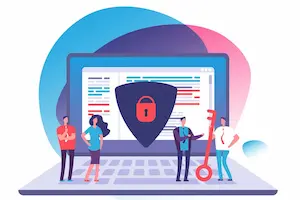23 Most Common Website Design Vulnerabilities for Small Businesses to Avoid
Posted By Remote Techs On 21-August-2024

We understand how critical it is for small businesses to safeguard their online presence.
Website design vulnerabilities can expose your business to various risks, from data breaches to malicious attacks.
This article explores the 23 most common website design vulnerabilities that small businesses must know and how to prevent them.
1. SQL Injection
SQL Injection is a prevalent vulnerability that allows attackers to manipulate your website’s database through malicious SQL queries. It can lead to unauthorized access or even data deletion. We implement prepared statements and parameterized queries at Remote Techs to mitigate this risk.
2. Cross-Site Scripting (XSS)
Cross-site scripting (XSS) allows attackers to inject malicious scripts into web pages viewed by other users. This can lead to data theft or session hijacking. We use input validation and encoding to prevent XSS attacks in all our web projects.
3. Cross-Site Request Forgery (CSRF)
Cross-Site Request Forgery (CSRF) tricks users into performing actions they did not intend. By using CSRF tokens, Remote Techs ensures that requests made on behalf of a user are legitimate and authorized.
4. Insecure Direct Object References (IDOR)
Insecure Direct Object References (IDOR) occur when attackers manipulate URLs or request parameters to gain access to data they should not be able to see. We use access controls and proper validation to prevent unauthorized data access.
5. Security Misconfiguration
Security Misconfiguration involves leaving default settings or misconfigured security controls, which can create vulnerabilities. We perform thorough security audits and ensure all configurations adhere to best practices.
6. Broken Authentication
Broken Authentication occurs when attackers exploit flaws in authentication mechanisms to gain unauthorized access. We implement robust authentication processes, including multi-factor authentication (MFA), to safeguard user accounts.
7. Sensitive Data Exposure
Sensitive Data Exposure involves failing to protect sensitive information such as credit card numbers or personal data. We use encryption and secure storage solutions to protect your website’s sensitive data.
8. Broken Access Control
Broken Access Control allows users to access resources they should not have permission to view or modify. Remote Techs enforces strict access control policies to ensure users can only access data and functions pertinent to their roles.
9. Insufficient Logging and Monitoring
More logging and monitoring must be needed to make it difficult for the deceased to respond to security incidents. We implement comprehensive logging and monitoring solutions to promptly track and respond to suspicious activities.
10. Using Outdated Components
Using Outdated Components exposes your website to vulnerabilities in outdated libraries or software. To mitigate this risk, we ensure all components are regularly updated and patched.
11. Invalidated Redirects and Forwards
If not properly validated, Invalidated Redirects and Forwards can lead users to malicious websites. We employ secure coding practices to validate and control all redirects and forwards within our web applications.
12. Insecure Communication
Insecure Communication involves transmitting data without proper encryption, making it susceptible to interception. Remote Techs uses HTTPS and secure communication protocols to protect data in transit.
13. Unnecessary Features
Unnecessary Features can introduce vulnerabilities if they are not properly secured. We regularly review website features and remove unnecessary ones to reduce the attack surface.
14. Weak Password Policies
Weak Password Policies can make it easier for attackers to gain unauthorized access. We enforce strong password policies and recommend password managers for secure credential management.
15. Improper Error Handling
Improper Error Handling can disclose sensitive information through error messages. Remote Techs ensure error messages are generic and do not reveal information that could be useful to attackers.
16. Lack of Security Updates
Lack of Security Updates can leave your website exposed to known vulnerabilities. We implement automated update mechanisms to ensure your website’s software and components are always up-to-date.
17. Insecure APIs
If not properly secured, insecure APIs can expose your website to attacks. To protect your APIs, we follow best practices for API security, including Authentication, authorization, and rate limiting.
18. Misconfigured HTTP Headers
Misconfigured HTTP Headers can lead to vulnerabilities such as clickjacking or content injection. Remote Techs configure HTTP headers to enforce security policies and protect against these attacks.
19. Insecure File Uploads
Insecure File Uploads can allow attackers to upload malicious files to your server. We implement strict file upload restrictions and scanning mechanisms to prevent the upload of harmful files.
20. Unsecured Development Environments
Unsecured Development Environments can expose your website to risks if not adequately protected. We ensure development environments are isolated and secured to prevent unauthorized access.
21. Insecure Cookie Handling
Insecure Cookie Handling can expose session data to attacks. Remote Techs sets cookies with secure attributes and implements proper session management to safeguard user sessions.
22. Inadequate Input Validation
Inadequate Input Validation can allow your website to process malicious data. We enforce robust input validation and sanitization to handle only safe data.
23. Lack of Security Training
Lack of Security Training can result in human errors that lead to vulnerabilities. Remote Techs provides security training and awareness programs to ensure everyone managing your website understands and adheres to best security practices.
We are committed to helping small businesses avoid these common website design vulnerabilities and secure their online presence. Following best practices and implementing robust security measures can protect your website from potential threats and ensure a safe and reliable user experience.